Geography Playlist
19 chapters • 0 completed
The Universe and the Earth
18 topics
Atmosphere and its composition
6 topics
Atmospheric Temperature
11 topics
Atmospheric Moisture
9 topics
Air Mass, Fronts & Cyclones
15 topics
Evolution of Earths Crust, Earthquakes and Volcanoes
23 topics
Interior of The Earth
14 topics
Landforms
25 topics
Geomorphic Processes
10 topics
Movement of Ocean Water
16 topics
Oceans and its Properties
12 topics
Climate of a Region
14 topics
Indian Geography - introduction, Geology
5 topics
Physiography of India
27 topics
Indian Climate
20 topics
Indian Drainage
32 topics
Soil and Natural Vegetation
13 topics
Mineral and Energy Resources, Industries in India
28 topics
Indian Agriculture
22 topics
Chapter 14: Physiography of India
Chapter TestHimalayas
The Himalayas (meaning 'Abode of Snow') are the world’s youngest, highest, and longest fold mountain system, formed through the collision of the Indian Plate with the Eurasian Plate. They continue to rise due to ongoing plate tectonics.
The Himalayas (meaning 'Abode of Snow') are the world’s youngest, highest, and longest fold mountain system, formed through the collision of the Indian Plate with the Eurasian Plate. They continue to rise due to ongoing plate tectonics.
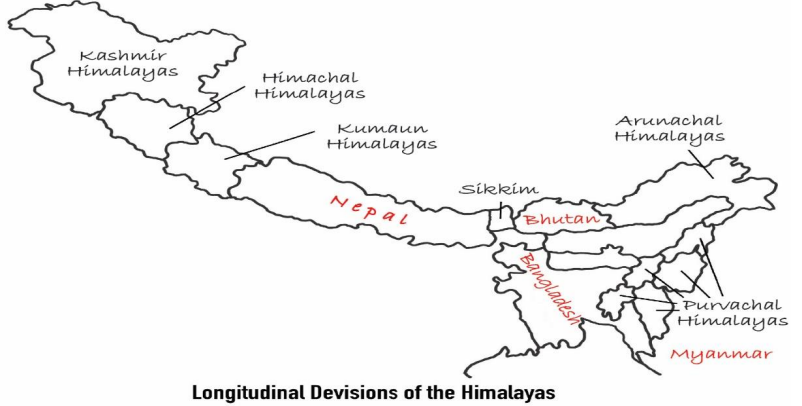
Himalayas – Key Aspects
| Aspect | Details |
|---|---|
| Meaning of Name | Himalaya = Abode of Snow |
| Type | Young fold mountain system |
| Age | Formed ~40–50 million years ago |
| Origin | Collision of Indian & Eurasian Plates |
| Geological Evidence | Marine fossils, folded sediments |
| Ongoing Rise | Indian Plate moves ~5 cm/year |
| Divisions | Trans, Greater, Lesser, Shiwaliks, Purvanchal |
| Importance | Climate, rivers, biodiversity, culture, defense |
Mains Key Points
Prelims Strategy Tips
Characteristic Features of the Himalayas
The Himalayas extend about 2400 km with varying width (200–500 km). They show unique features such as syntaxial bends, very high peaks, steep southern slopes, asymmetrical topography, and a link with Central Asian ranges through the Pamir Knot.
The Himalayas extend about 2400 km with varying width (200–500 km). They show unique features such as syntaxial bends, very high peaks, steep southern slopes, asymmetrical topography, and a link with Central Asian ranges through the Pamir Knot.
Characteristic Features of the Himalayas
| Feature | Details |
|---|---|
| Extension | 2400 km (Indus gorge to Brahmaputra gorge) |
| Width | 200–500 km (400 km in Kashmir, 150 km in Arunachal) |
| Link | Connected to Central Asian ranges via Pamir Knot |
| High Peaks | 14 peaks >8000m, 20 peaks >7500m |
| Syntaxial Bends | Nanga Parbat (NW), Namcha Barwa (NE) |
| River Gorges | Indus (west), Brahmaputra/Dihang (east) |
| Slopes | Steep in south (India), gentle in north (Tibet) |
| Topography | Asymmetrical, valleys, gorges, youthful rivers |
Mains Key Points
Prelims Strategy Tips
Tuting-Tidding Suture Zone & Divisions of the Himalayas
The Tuting-Tidding Suture Zone (TTSZ) lies in the Eastern Himalayas where the mountains bend sharply southward and connect with the Indo-Burma Range. The Himalayas are divided north-to-south into Trans Himalayas, Greater Himalayas (Himadri), Lesser Himalayas (Himachal), and Outer Himalayas (Shiwalik).
The Tuting-Tidding Suture Zone (TTSZ) lies in the Eastern Himalayas where the mountains bend sharply southward and connect with the Indo-Burma Range. The Himalayas are divided north-to-south into Trans Himalayas, Greater Himalayas (Himadri), Lesser Himalayas (Himachal), and Outer Himalayas (Shiwalik).
Divisions of the Himalayas – North to South
| Division | Features |
|---|---|
| Trans Himalayas | North of Greater Himalayas; includes Karakoram, Ladakh, Zaskar, Kailash. |
| Greater Himalayas (Himadri) | Highest range; Mt. Everest, Kanchenjunga; average elevation >6000 m. |
| Lesser Himalayas (Himachal) | Ranges like Pir Panjal, Dhauladhar; average elevation 3500–4500 m. |
| Outer Himalayas (Shiwalik) | Youngest; unconsolidated sediments; average elevation 900–1200 m. |
Mains Key Points
Prelims Strategy Tips
Divisions of the Himalayas – Greater, Lesser & Outer
The Himalayas are divided into three major ranges: the Greater Himalayas (Himadri), the Lesser Himalayas (Himachal), and the Outer Himalayas (Shiwalik). Each range differs in elevation, composition, width, and topography, but together they form the backbone of the Indian subcontinent's physiography.
The Himalayas are divided into three major ranges: the Greater Himalayas (Himadri), the Lesser Himalayas (Himachal), and the Outer Himalayas (Shiwalik). Each range differs in elevation, composition, width, and topography, but together they form the backbone of the Indian subcontinent's physiography.
Comparison of Major Himalayan Divisions
| Division | Elevation | Width | Composition | Notable Features |
|---|---|---|---|---|
| Greater Himalayas (Himadri) | ~6000 m | 25 km | Granite | Everest, Kanchenjunga, major glaciers (Siachen, Gangotri). |
| Lesser Himalayas (Himachal) | 3700–4500 m | 60–80 km | Metamorphosed rocks | Pir Panjal, Dhauladhar, valleys (Kashmir, Kangra, Kullu), hill towns (Shimla, Darjeeling). |
| Outer Himalayas (Shiwalik) | 900–1100 m | 15–50 km | Unconsolidated sediments | Duns (Dehradun), Duars, Chos (Hoshiarpur). |
Mains Key Points
Prelims Strategy Tips
Longitudinal Divisions of the Himalayas
The Himalayas are longitudinally divided into Western (Indus to Kali), Eastern (Kali to Brahmaputra), and North-Eastern Hills (Purvanchal). Each section has distinct physiography, culture, and strategic significance.
The Himalayas are longitudinally divided into Western (Indus to Kali), Eastern (Kali to Brahmaputra), and North-Eastern Hills (Purvanchal). Each section has distinct physiography, culture, and strategic significance.
Longitudinal Divisions of the Himalayas
| Division | Extent | Features |
|---|---|---|
| Western Himalayas | Indus to Kali River | Punjab Himalayas (Kashmir, Kangra valleys, Nanga Parbat), Kumaon Himalayas (Nanda Devi, Kamet, Nainital). |
| Eastern Himalayas | Kali to Brahmaputra River | Nepal (Everest, Kanchenjunga), Sikkim (Kanchenjunga, biodiversity), Assam Himalayas (rainfall, tea). |
| North-Eastern Hills (Purvanchal) | South of Brahmaputra valley | Patkai, Naga, Lushai, Mizo hills; folded, forested, SE Asia linkage. |
Mains Key Points
Prelims Strategy Tips
Western, Eastern & North-Eastern Himalayas
The Himalayas are divided longitudinally into Western, Eastern, and North-Eastern Hills (Purvanchal). Each subdivision has unique peaks, passes, valleys, and strategic significance.
The Himalayas are divided longitudinally into Western, Eastern, and North-Eastern Hills (Purvanchal). Each subdivision has unique peaks, passes, valleys, and strategic significance.
Western, Eastern & North-Eastern Himalayas – Key Aspects
| Division | Extent | Major Features |
|---|---|---|
| Punjab Himalayas | Indus–Sutlej | Ranges: Karakoram, Pir Panjal; Karewas (saffron cultivation). |
| Kumaon Himalayas | Sutlej–Kali | Peaks: Nanda Devi, Kedarnath; Hill stations: Nainital, Mussoorie; Passes: Lipulekh. |
| Nepal Himalayas | Kali–Kosi | Tallest section; Everest, Kanchenjunga, Annapurna. |
| Sikkim Himalayas | Kosi–Teesta | Kanchenjunga; Jelep-La pass (India-China-Bhutan junction). |
| Assam Himalayas | Teesta–Dihang | Namcha Barwa, Kula Kangri; Diphu pass; high rainfall. |
| Purvanchal | South of Brahmaputra | Patkai, Naga, Manipur, Mizo hills; sedimentary rocks; extension into Myanmar (Arakan Yoma). |
Mains Key Points
Prelims Strategy Tips
Comparison between Western and Eastern Himalayas
The Western Himalayas (Indus to Kali) and Eastern Himalayas (Kali to Dihang) differ in slopes, climate, snowline, and prominent peaks due to their latitudinal location and physiography.
The Western Himalayas (Indus to Kali) and Eastern Himalayas (Kali to Dihang) differ in slopes, climate, snowline, and prominent peaks due to their latitudinal location and physiography.
Comparison of Western & Eastern Himalayas
| Aspect | Western Himalayas | Eastern Himalayas |
|---|---|---|
| Extent | Indus River to Kali River | Kali River to Dihang River |
| Slopes | Low and gradual | Steep and sudden |
| Climate | Colder (higher latitude) | Warmer (lower latitude) |
| Snowline | Lower altitude | Higher altitude |
| Major Peaks | Nanga Parbat, Nanda Devi, Badrinath | Everest, Makalu, Annapurna, Dhaulagiri |
Mains Key Points
Prelims Strategy Tips
Passes in the Himalayas
A pass is a natural gap or break in high rugged terrain, providing connectivity across Himalayan ranges. Passes in the Himalayas have historically been crucial for trade, cultural exchange, and strategic defense.
A pass is a natural gap or break in high rugged terrain, providing connectivity across Himalayan ranges. Passes in the Himalayas have historically been crucial for trade, cultural exchange, and strategic defense.
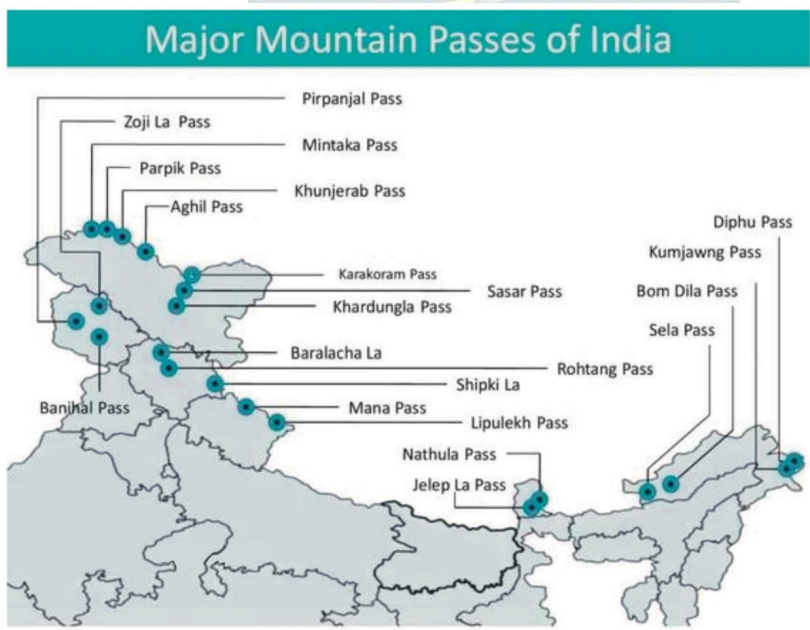
Major Passes in the Himalayas
| Pass | Location | Connectivity/Importance |
|---|---|---|
| Pir Panjal | J&K | Connects Jammu with Kashmir Valley |
| Banihal | J&K | Links Jammu and Srinagar (now tunnel) |
| Burzil | J&K | Srinagar–Gilgit; connects to Deosai Plains |
| Zoji La | J&K (Zaskar Range) | Connects Srinagar to Leh (strategic Ladakh route) |
| Shipki La | Himachal Pradesh | Sutlej River passes; connects Shimla to Tibet |
| Baralacha La | Himachal Pradesh | Mandi to Leh road link |
| Rohtang | Himachal Pradesh | Connects Manali to Leh |
| Niti | Uttarakhand | Route to Kailash–Mansarovar |
| Nathu La | Sikkim | Connects Darjeeling (India) with Tibet; Indo-China trade |
| Jelep La | Sikkim (Tri-junction) | India-China-Bhutan tri-junction; strategic importance |
Mains Key Points
Prelims Strategy Tips
Significance of the Himalayas
The Himalayas are vital for India’s climate, defense, rivers, hydroelectricity, biodiversity, agriculture, tourism, and minerals. They act as a climatic barrier, a source of rivers, a storehouse of forests and minerals, and support cultural and economic life.
The Himalayas are vital for India’s climate, defense, rivers, hydroelectricity, biodiversity, agriculture, tourism, and minerals. They act as a climatic barrier, a source of rivers, a storehouse of forests and minerals, and support cultural and economic life.
Significance of the Himalayas – Key Aspects
| Aspect | Details |
|---|---|
| Climate | Barrier for monsoon; prevents cold winds from Central Asia |
| Defense | Natural barrier against invasions; strategic frontier |
| Rivers | Indus, Ganga, Brahmaputra systems |
| Hydroelectricity | Potential of ~334 GW in Hindukush Himalayas |
| Forests | Timber, fuel, raw materials, medicinal plants |
| Agriculture | Fertile Indo-Gangetic plains |
| Tourism | Hill stations + adventure tourism |
| Minerals | Oil, gas, copper, limestone, gold, nickel, silver |
Mains Key Points
Prelims Strategy Tips
Snowline, Glaciers & Karakoram Anomaly
The snowline is the lower altitudinal limit of permanent snow, which varies in the Himalayas due to latitude, precipitation, slope, and topography. The Karakoram Anomaly refers to the unusual stability or growth of glaciers in the Karakoram, unlike the retreat observed elsewhere.
The snowline is the lower altitudinal limit of permanent snow, which varies in the Himalayas due to latitude, precipitation, slope, and topography. The Karakoram Anomaly refers to the unusual stability or growth of glaciers in the Karakoram, unlike the retreat observed elsewhere.
Snowline Variation in Himalayas
| Region | Snowline (approx.) |
|---|---|
| Western Himalayas | 2500 m |
| Kumaon Himalayas | 3500 m |
| Eastern Himalayas | 3500 m+ |
Karakoram Anomaly vs Other Himalayas
| Region | Glacier Trend |
|---|---|
| Karakoram | Stable or growing glaciers (Karakoram Anomaly) |
| Other Himalayas | Retreating glaciers due to climate change |
Mains Key Points
Prelims Strategy Tips
Major Glaciers in the Himalayas
The Himalayas house some of the world’s largest glaciers outside the polar regions, especially in the Karakoram range. Glaciers are important sources of perennial rivers like Ganga, Yamuna, and Indus.
The Himalayas house some of the world’s largest glaciers outside the polar regions, especially in the Karakoram range. Glaciers are important sources of perennial rivers like Ganga, Yamuna, and Indus.
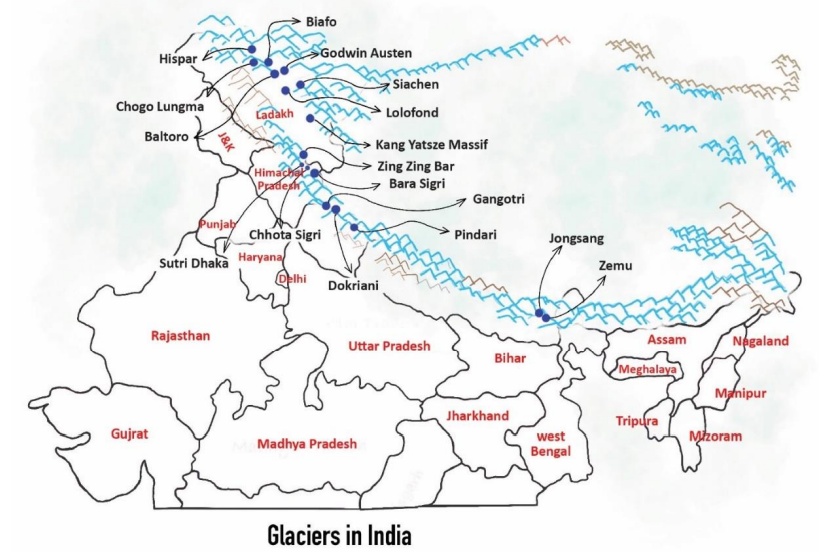
Major Glaciers of the Himalayas
| Glacier | State/Region | Range |
|---|---|---|
| Biafo | Jammu & Kashmir | Karakoram |
| Hispar | Jammu & Kashmir | Karakoram |
| Chogo Lungma | Gilgit Baltistan | Karakoram |
| Baltoro | Gilgit Baltistan | Karakoram |
| Godwin Austen | Jammu & Kashmir | Karakoram |
| Siachen | Jammu & Kashmir | Karakoram |
| Lolofond | Jammu & Kashmir | Karakoram |
| Kang Yatsze massif | Ladakh (Markha Valley) | Trans-Himalaya |
| Zing Zing Bar | Himachal Pradesh | Himalaya |
| Bara Sigri | Himachal Pradesh | Himalaya |
| Sutri Dhaka | Himachal Pradesh | Himalaya |
| Chhota Sigri | Himachal Pradesh | Himalaya |
| Gangotri | Uttarakhand | Himalaya |
| Pindari | Uttarakhand | Himalaya |
| Jongsong | Sikkim | Himalaya |
| Zemu | Sikkim | Himalaya |
Mains Key Points
Prelims Strategy Tips
Northern Plains of India
The Northern Plains are the youngest physiographic feature of India, covering less than one-third of the area but supporting over 40% of the population. Formed by alluvial deposits of the Indus, Ganga, and Brahmaputra systems, they are among the world’s largest alluvial tracts.
The Northern Plains are the youngest physiographic feature of India, covering less than one-third of the area but supporting over 40% of the population. Formed by alluvial deposits of the Indus, Ganga, and Brahmaputra systems, they are among the world’s largest alluvial tracts.
Northern Plains – Key Features
| Aspect | Details |
|---|---|
| Location | South of Shiwaliks, north of Peninsular India |
| Rivers | Indus, Ganga, Brahmaputra systems |
| Extent | 3200 km (east-west) |
| Width | 150–300 km (widest in west) |
| Alluvial Depth | 1300–1400 m (south), >8000 m near Shiwaliks |
| Topography | Monotonous, river levees, micro undulations |
Mains Key Points
Prelims Strategy Tips
Physiographic Divisions of Northern Plains
The Northern Plains are divided into Bhabar, Tarai, Bhangar, and Khadar. These represent different stages of alluvial deposition and drainage characteristics, influencing agriculture, vegetation, and settlement.
The Northern Plains are divided into Bhabar, Tarai, Bhangar, and Khadar. These represent different stages of alluvial deposition and drainage characteristics, influencing agriculture, vegetation, and settlement.
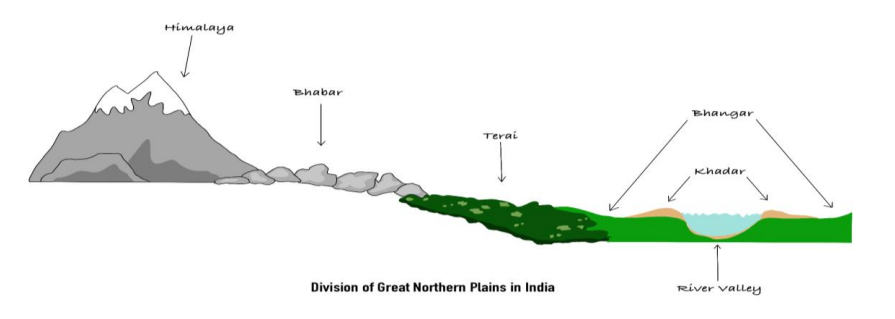
Divisions of Northern Plains
| Division | Features |
|---|---|
| Bhabar | 8–10 km belt of coarse sediments; porous; rivers disappear; dry beds; unsuitable for farming |
| Tarai | South of Bhabar; swampy; marshy; re-emerging streams; fertile but unhealthy |
| Bhangar | Old alluvium; terraces; dark, clayey, humus-rich; has kankar; found in doabs |
| Khadar | New alluvium; floodplains; sandy, porous, fertile; renewed annually |
Mains Key Points
Prelims Strategy Tips
Regional Division of Northern Plains – Punjab Plains
The Punjab Plains form the western part of the Northern Plains, shaped by the Indus and its tributaries. Characterized by doabs, Bets, shifting sand dunes, and the Haryana Tract, they represent a fertile but diverse physiographic region.
The Punjab Plains form the western part of the Northern Plains, shaped by the Indus and its tributaries. Characterized by doabs, Bets, shifting sand dunes, and the Haryana Tract, they represent a fertile but diverse physiographic region.
Punjab Plains – Key Features
| Aspect | Details |
|---|---|
| Location | Western part of Northern Plains; Delhi-Aravalli ridge separates from Ganga Plains |
| Rivers | Indus, Jhelum, Chenab, Ravi, Beas, Sutlej |
| Divisions | Doabs (interfluvial tracts) |
| Floodplains | Bets (Khadar floodplains, locally ‘Dhayas’) |
| Erosion Features | Chhos (seasonal streams from Shiwalik erosion) |
| South-west Part | Marked by shifting sand dunes |
| Special Areas | Malwa Plain (Sutlej south), Haryana Tract (Ghaggar–Yamuna divide) |
| Ghaggar River | Considered present-day successor of Saraswati |
Mains Key Points
Prelims Strategy Tips
Regional Divisions of Northern Plains – Rajasthan, Ganga & Brahmaputra Plains
The Northern Plains are regionally divided into Punjab, Rajasthan, Ganga, and Brahmaputra Plains. Rajasthan Plains include the Thar Desert, Ganga Plains form the largest alluvial stretch with the world’s biggest delta, and Brahmaputra Plains are rich in biodiversity and riverine features.
The Northern Plains are regionally divided into Punjab, Rajasthan, Ganga, and Brahmaputra Plains. Rajasthan Plains include the Thar Desert, Ganga Plains form the largest alluvial stretch with the world’s biggest delta, and Brahmaputra Plains are rich in biodiversity and riverine features.
Regional Divisions of Northern Plains
| Region | Key Features |
|---|---|
| Rajasthan Plains | Thar Desert (Marusthali), Rajasthan Bagar, Luni River, saline lakes (Sambhar, Didwana) |
| Ganga Plains | Yamuna–Bangladesh extent, fertile alluvium, flood-prone, Kosi River, Ganga-Brahmaputra Delta (Sunderbans) |
| Brahmaputra Plains | Assam plains, Brahmaputra River, riverine islands, ox-bow lakes, Kaziranga & Manas National Parks |
Mains Key Points
Prelims Strategy Tips
Significance of the Northern Plains
The Northern Plains, with fertile soils and perennial rivers, are agriculturally rich, culturally significant, and useful for navigation. They are often called the ‘Granary of India’.
The Northern Plains, with fertile soils and perennial rivers, are agriculturally rich, culturally significant, and useful for navigation. They are often called the ‘Granary of India’.
Significance of Northern Plains
| Aspect | Importance |
|---|---|
| Agriculture | Fertile soil, perennial rivers, irrigation → ‘Granary of India’ |
| Cultural | Sacred river confluences, pilgrimage sites, cultural heritage |
| Navigation | Broad rivers support inland navigation and trade |
Mains Key Points
Prelims Strategy Tips
The Great Indian Desert (Thar Desert)
The Thar Desert, the 9th largest desert in the world, lies in northwestern India. Though geologically part of the Peninsular Plateau, it is classified under plains due to its flat surface. Locally known as Marusthali, it is marked by aridity, sand dunes, saline lakes, and seasonal streams.
The Thar Desert, the 9th largest desert in the world, lies in northwestern India. Though geologically part of the Peninsular Plateau, it is classified under plains due to its flat surface. Locally known as Marusthali, it is marked by aridity, sand dunes, saline lakes, and seasonal streams.
Great Indian Desert – Key Features
| Aspect | Details |
|---|---|
| Extent | NW Aravallis to Cholistan Desert (Pakistan) |
| Local Name | Marusthali (‘Dead Land’) |
| Semi-desert Region | Bagar (thin sand cover, seasonal streams, salt lakes) |
| Fertile Patches | Rohi (cultivable spots) |
| River | Luni – seasonal, from Pushkar valley |
| Inland Drainage | Streams → playas/lakes (Sambhar, Didwana, etc.) |
| Landforms | Sand dunes, barchans, mushroom rocks, oases |
| Geology | Once under sea; uplift during Pleistocene |
Mains Key Points
Prelims Strategy Tips
Peninsular Plateau of India
The Peninsular Plateau is the largest physiographic unit of India. It is a stable tableland made of old crystalline igneous and metamorphic rocks, associated with the Gondwana land. Rich in minerals, it has diverse physiographic features like plateaus, hill ranges, valleys, and rift structures.
The Peninsular Plateau is the largest physiographic unit of India. It is a stable tableland made of old crystalline igneous and metamorphic rocks, associated with the Gondwana land. Rich in minerals, it has diverse physiographic features like plateaus, hill ranges, valleys, and rift structures.
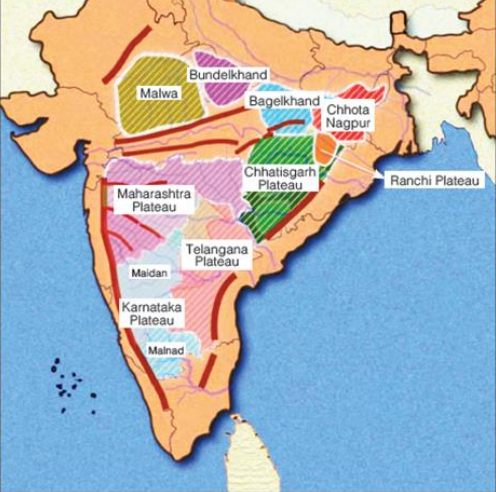
Peninsular Plateau – Key Aspects
| Aspect | Details |
|---|---|
| Extent | South of Northern Plains; Aravalli to Rajmahal, Gir to Cardamom Hills |
| Elevation | 600–900 m |
| Composition | Ancient igneous & metamorphic rocks |
| Rift Valleys | Narmada & Tapti |
| Erosional Features | Ravines (Chambal), Tors |
| Unique Gaps | Garo–Rajmahal Gap |
| Mineral Resources | Coal (98% of India), iron, gold, copper, uranium |
Mains Key Points
Prelims Strategy Tips
Plateaus of Peninsular India
The Peninsular Plateau is divided into the Central Highlands, the Deccan Plateau, and the North-Eastern Plateau. Each region has unique physiography, elevation, geology, and resource distribution, making it the mineral and agricultural heart of India.
The Peninsular Plateau is divided into the Central Highlands, the Deccan Plateau, and the North-Eastern Plateau. Each region has unique physiography, elevation, geology, and resource distribution, making it the mineral and agricultural heart of India.
Plateaus of Peninsular India – Key Features
| Plateau | Location / Features |
|---|---|
| Central Highlands | North of Narmada; Marwar, Malwa, Bundelkhand, Chhotanagpur |
| Marwar Upland | East of Aravallis; 250–500 m; rolling plains; Chambal & Banas erosion |
| Malwa Plateau | MP; basaltic lava, black soil; cotton cultivation |
| Bundelkhand Plateau | UP–MP; dissected upland; granite & sandstone; semi-arid |
| Chhotanagpur Plateau | Jharkhand–Chhattisgarh–WB; mineral rich; Patland (‘Ruhr of India’) |
| Deccan Plateau | South of Narmada; volcanic trap structure; Maharashtra, Karnataka, Telangana sub-plateaus |
| Maharashtra Plateau | Basaltic lava; regur soil; Godavari & Krishna valleys |
| Karnataka Plateau | Mysore Plateau; Malnad (hilly) & Maidan (plain) |
| Telangana Plateau | Archaean gneiss; peneplains + ghats; drained by Godavari, Krishna, Penneru |
| North-Eastern Plateau | Meghalaya/Shillong; Garo, Khasi, Jaintia, Mikir hills; heavy rainfall, eroded |
Mains Key Points
Prelims Strategy Tips
Hill Ranges of the Peninsular Plateau
The hill ranges of Peninsular India are among the oldest mountains in the world. They are residual, denuded mountains with local significance, acting as watersheds, influencing rainfall, and serving as biodiversity hotspots.
The hill ranges of Peninsular India are among the oldest mountains in the world. They are residual, denuded mountains with local significance, acting as watersheds, influencing rainfall, and serving as biodiversity hotspots.
Major Hill Ranges of Peninsular India
| Range | Extent | Elevation (m) | Highest Peak | Passes | Rivers/Drainage | Key Features |
|---|---|---|---|---|---|---|
| Aravali | Delhi to Gujarat–Rajasthan (~800 km, NE–SW) | 400–600 | Guru Shikhar (1722 m, Mount Abu) | Pipli, Dewair, Desuri | Small west-flowing seasonal rivers → Luni basin | Oldest fold mountains; once higher than Himalayas; locally ‘Jarga’ (Udaipur), ‘Delhi Ridge’. |
| Vindhyan | Parallel to Narmada–Son valley (1200 km, E–W) | 300–650 | Kalumar Peak (752 m) | — | North drains into Ganga; South into Narmada | Made of sedimentary rocks; plateau escarpments; cultural divide between North & South India. |
| Satpura | Between Narmada & Tapti (MP–MH border) | 600–900 | Dhupgarh (1350 m, Pachmarhi, Mahadeo Hills) | — | Narmada flows west, Tapti parallel south | ‘Sat+pura’ = seven folds; includes Mahadeo, Maikal ranges; forested; tiger reserves. |
| Western Ghats (Sahyadris) | Tapti Valley to Kanyakumari, parallel to west coast | 900–1600 | Anai Mudi (2695 m, Kerala) – highest in South India | Thal Ghat, Bhor Ghat, Palakkad Gap, Agumbe Ghat | West short swift rivers; East → Godavari, Krishna, Kaveri | Continuous escarpment; UNESCO biodiversity hotspot; heavy orographic rainfall; source of peninsular rivers. |
| Eastern Ghats | Mahanadi (Odisha) to Nilgiris (TN); discontinuous | 600 | Mahendragiri (1501 m, Odisha) | — | Drained by east-flowing rivers (Mahanadi, Godavari, Krishna) | Residual, broken hills; include Javadi, Shevaroy, Nallamala, Palkonda; less rainfall effect. |
Mains Key Points
Prelims Strategy Tips
Mountain Peaks of Peninsular India
The Peninsular Plateau, though older and eroded compared to the Himalayas, has important peaks spread across Western Ghats, Eastern Ghats, Aravallis, Satpura, Nilgiris, Khasi, and Deccan ranges. These peaks are significant for geography, ecology, and culture.
The Peninsular Plateau, though older and eroded compared to the Himalayas, has important peaks spread across Western Ghats, Eastern Ghats, Aravallis, Satpura, Nilgiris, Khasi, and Deccan ranges. These peaks are significant for geography, ecology, and culture.
Major Peaks of Peninsular India
| Peak | Range | State | Height (m) |
|---|---|---|---|
| Anamudi | Western Ghats | Kerala | 2695 |
| Doddabetta | Nilgiri Hills | Tamil Nadu | 2637 |
| Phawngpui (Blue Mountain) | Mizo Hills | Mizoram | 2157 |
| Shillong Peak | Khasi Hills | Meghalaya | 1965 |
| Mullayanagiri | Western Ghats | Karnataka | 1930 |
| Guru Shikhar | Aravalli Range | Rajasthan | 1722 |
| Arma Konda | Eastern Ghats | Andhra Pradesh | 1680 |
| Deomali | Eastern Ghats | Odisha | 1672 |
| Kalsubai | Western Ghats | Maharashtra | 1646 |
| Mahendragiri | Eastern Ghats | Odisha | 1501 |
| Dhupgarh | Satpura | Madhya Pradesh | 1350 |
| Bailadila Range | Bastar Hills | Chhattisgarh | 1276 |
| Malaygiri | Eastern Ghats | Odisha | 1187 |
| Sonsogor | Western Ghats | Goa | 1166 |
| Girnar | Junagadh Hills | Gujarat | 1069 |
| Doli Gutta | Deccan Plateau | Telangana–Chhattisgarh border | 965 |
| Amsot Peak | Shivalik Hills | Uttar Pradesh | 945 |
| Betalongchhip | Jampui Hills | Tripura | 930 |
| Someshwar Fort Peak | Someshwar Hills | Bihar | 880 |
Mains Key Points
Prelims Strategy Tips
Major Passes in Peninsular India
Passes in the Peninsular Plateau are important corridors through the Western Ghats and Aravallis, facilitating trade, transport, and historically battles. They also connect different cultural and ecological zones.
Passes in the Peninsular Plateau are important corridors through the Western Ghats and Aravallis, facilitating trade, transport, and historically battles. They also connect different cultural and ecological zones.
Major Passes of Peninsular India
| Pass | Location/Range | State | Significance |
|---|---|---|---|
| Thal Ghat (Kasara Ghat) | Western Ghats, between Mumbai–Nashik | Maharashtra | Steepest railway line in India; major road & rail route to Mumbai |
| Bhor Ghat | Western Ghats, between Palasdari and Khandala | Maharashtra | Developed by Satavahanas; important trade route; connects Deccan with Konkan coast |
| Pal Ghat (Palakkad Gap) | Between Nilgiri Hills & Anamalai Hills, Western Ghats | Tamil Nadu–Kerala border | Low mountain gap facilitating trade & cultural exchange; link between Tamil Nadu & Kerala |
| Haldighati Pass | Aravalli Range, between Rajsamand & Pali districts | Rajasthan | Site of 1576 battle between Maharana Pratap and Man Singh (Mughal army); historical significance |
Mains Key Points
Prelims Strategy Tips
Significance of the Peninsular Plateau
The Peninsular Plateau is the storehouse of India’s mineral wealth, agricultural soils, hydropower sites, and hill stations, making it a vital physiographic unit for economy, agriculture, and tourism.
The Peninsular Plateau is the storehouse of India’s mineral wealth, agricultural soils, hydropower sites, and hill stations, making it a vital physiographic unit for economy, agriculture, and tourism.
Significance of the Peninsular Plateau
| Aspect | Importance |
|---|---|
| Minerals | Iron, manganese, coal, copper, bauxite, mica, gold, marble etc. |
| Soil | Black regur soil → excellent for cotton. |
| Agriculture | Cotton, maize, citrus fruits, tea, coffee, rubber, pulses. |
| Hydropower | Rivers and waterfalls (Jog, Shivanasamudra) → hydel power sites. |
| Tourism | Hill stations like Ooty, Mahabaleshwar; biodiversity hotspots. |
Mains Key Points
Prelims Strategy Tips
Coastal Plains of India
The Coastal Plains of India are narrow strips of lowlands lying along both sides of the Peninsular Plateau. They stretch for about 7515 km, covering nine states and four union territories. They vary in width and physiography from north to south.
The Coastal Plains of India are narrow strips of lowlands lying along both sides of the Peninsular Plateau. They stretch for about 7515 km, covering nine states and four union territories. They vary in width and physiography from north to south.

Coastal Plains of India – Key Facts
| Feature | Details |
|---|---|
| Total Coastline | 7515 km |
| No. of States | 9 |
| No. of Union Territories | 4 |
| State with Longest Coastline | Gujarat |
| UT with Longest Coastline | Andaman & Nicobar Islands |
Mains Key Points
Prelims Strategy Tips
Classification of Coastal Plains of India
India’s coastal plains are classified into Western Coastal Plains (Arabian Sea) and Eastern Coastal Plains (Bay of Bengal). They differ in physiography, rainfall, deltas, ports, and economic significance.
India’s coastal plains are classified into Western Coastal Plains (Arabian Sea) and Eastern Coastal Plains (Bay of Bengal). They differ in physiography, rainfall, deltas, ports, and economic significance.
Comparison between Western and Eastern Coastal Plains
| Aspect | Western Coastal Plains | Eastern Coastal Plains |
|---|---|---|
| Extent | Gulf of Khambhat (Gujarat) to Cape Comorin (Kanyakumari); avg. width ~50 km. Divisions: Konkan (Maharashtra), Karnataka, Malabar (Kerala). | Ganga delta to Kanyakumari; wider coast. Divisions: Utkal (Odisha), Coromandel (Tamil Nadu & Andhra Pradesh). |
| Coast Type | Submerged coast; narrow in middle, broader north & south. | Emergent coast; wide coastal plains. |
| Rivers & Deltas | Rivers are short; no major deltas; estuaries common. | Large rivers form extensive deltas – Mahanadi, Godavari, Krishna, Cauvery. |
| Ports & Harbours | Natural harbours; well-suited for ports (Kandla, Mumbai, JNPT, Kochi). | Fewer natural harbours due to siltation; fewer major ports. |
| Rainfall | Directly hit by SW monsoon; wetter region. | Parallel to monsoon winds; less rainfall comparatively. |
| Unique Features | Creeks, coves, estuaries; Malabar backwaters (Kayals, e.g., Vembanad Lake). | Deltas; Chilika Lake (largest saltwater lagoon in India). |
Mains Key Points
Prelims Strategy Tips
Andaman & Nicobar Islands
The Andaman & Nicobar Islands, located in the Bay of Bengal, are known as the 'Emerald Islands'. They extend from Landfall Island in the north to Indira Point in the south. They are volcanic in origin and ecologically rich.
The Andaman & Nicobar Islands, located in the Bay of Bengal, are known as the 'Emerald Islands'. They extend from Landfall Island in the north to Indira Point in the south. They are volcanic in origin and ecologically rich.
Key Features – Andaman & Nicobar Islands
| Aspect | Details |
|---|---|
| Location | Bay of Bengal |
| Extent | Landfall Island (north) → Indira Point (south) |
| Division | Andaman (North, Middle, South, Little) & Nicobar (Car, Little, Great) |
| Channel | Ten Degree Channel separates Andaman & Nicobar |
| Volcanoes | Barren (active), Narcondam (dormant) |
| Highest Peak | Saddle Peak (North Andaman) |
| Largest Island | Great Nicobar |
Mains Key Points
Prelims Strategy Tips
Lakshadweep and Minicoy Islands & Other Important Islands
Lakshadweep, Minicoy, and Amindivi form India’s smallest Union Territory in the Arabian Sea, made entirely of coral deposits. India also has significant riverine, barrier, and offshore islands like Majuli, Sriharikota, and Rameshwaram.
Lakshadweep, Minicoy, and Amindivi form India’s smallest Union Territory in the Arabian Sea, made entirely of coral deposits. India also has significant riverine, barrier, and offshore islands like Majuli, Sriharikota, and Rameshwaram.
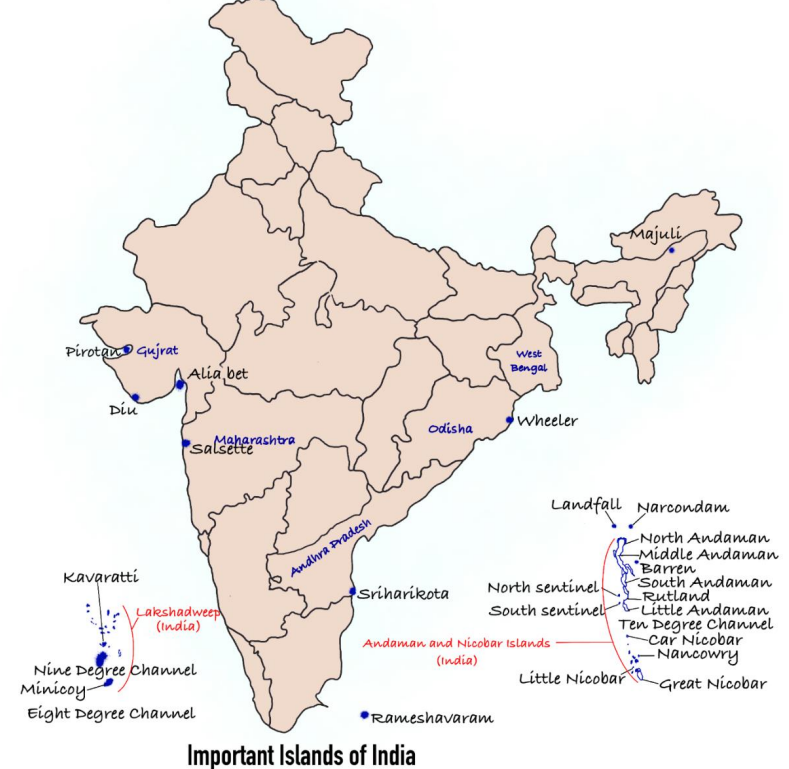
Key Features – Lakshadweep & Other Islands
| Island | Key Feature |
|---|---|
| Lakshadweep | Coral islands; 36 total, 11 inhabited; Minicoy is largest. |
| Majuli (Assam) | World’s largest freshwater island; first island district. |
| Salsette (Maharashtra) | Mumbai city located here. |
| Sriharikota (AP) | Barrier island; ISRO satellite launch site. |
| Aliabet (Gujarat) | First offshore oil well site of India. |
| Wheeler Island (Odisha) | Missile testing station (Abdul Kalam Island). |
| Pirotan (Gujarat) | Marine National Park islands; mangroves present. |
| Diu (Gujarat) | South of Kathiawar Peninsula. |
| Rameshwaram (TN) | Near Sri Lanka; linked by Pamban Bridge. |
| Hope Island (AP) | Tadpole-shaped island in Bay of Bengal. |
Mains Key Points
Prelims Strategy Tips
Chapter Complete!
Ready to move to the next chapter?
